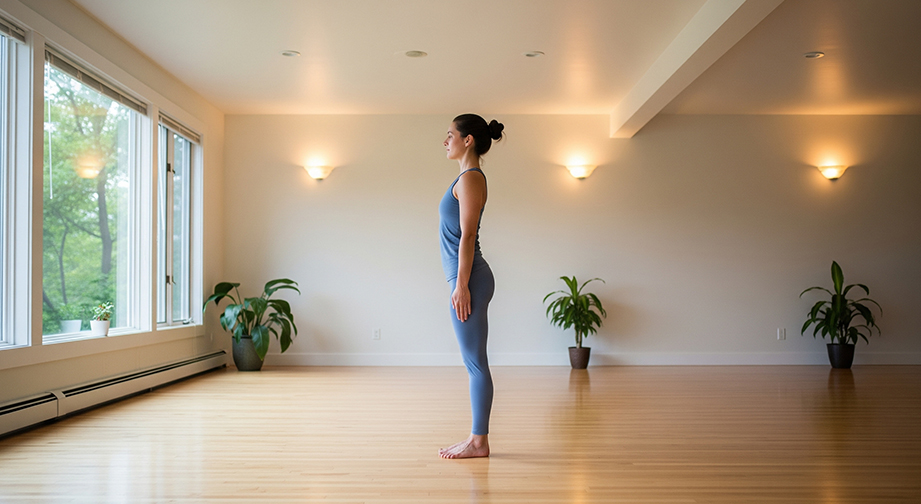Tadasana (Mountain Pose): Stand Tall and Reclaim Your Foundation
Introduction
Tadasana, also known as Mountain Pose, is a foundational yoga asana that teaches the art of standing well. In Sanskrit, “Tada” means “mountain,” and “Asana” means “pose.” The essence of Tadasana is steady balance and calm presence.
If you’ve ever felt stiff or cramped after sitting at your desk for hours, Tadasana can be your best friend! This simple yet powerful posture helps you reset your alignment, boost energy, and ground your mind.
Step-by-Step Guide: How to Do Tadasana

- Stand with Feet Together: Place your big toes to touch, heels slightly apart. Distribute your weight evenly on both feet.
- Engage Your Legs: Lift your kneecaps gently and firm your thighs without locking your knees.
- Lengthen the Spine: Tuck your tailbone slightly, drawing your belly in. Lengthen upwards from your feet to the crown of your head.
- Open the Chest: Roll your shoulders back and down, keeping arms relaxed at your sides with palms facing forward.
- Align the Head: Keep your chin parallel to the floor, gaze soft and straight ahead.
- Breathing: Inhale deeply as you imagine growing taller; exhale slowly, feeling all four corners of your feet connect to the ground.
- Stay: Hold Tadasana for 30 seconds to 1 minute. Repeat 2–3 rounds or as needed.
Beginner Modifications:
- Stand with feet hip-width apart for more stability.
- Practice against a wall for back and heel alignment.
For Advanced Practitioners:
- Close your eyes to challenge your balance.
- Raise your arms overhead, keeping shoulders relaxed.
- Practice lifting your heels to come onto the balls of your feet (Urdhva Hastasana).
Alignment & Safety Tips
- Alignment Cues:
- Engage thighs and core, avoid collapsing in the lower back.
- Even weight distribution: Heel to toe, left to right.
- Head, shoulders, hips, and heels should be in one line (like a mountain!).
- Common Mistakes:
- Locking knees—keep them soft.
- Letting ribs stick out—draw them in gently.
- Uneven weight on feet—press down evenly.
- Safety Precautions: Avoid if you are feeling dizzy, have severe low blood pressure, or have a recent lower limb injury. If pregnant, keep feet hip-width apart for comfort.
Benefits of Tadasana
- Physical Benefits:
- Improves posture & balance
- Strengthens legs, core, and ankles
- Relieves back and shoulder tension
- Mental Benefits:
- Reduces stress and anxiety
- Increases body awareness & focus
- Brings a sense of calm and grounding
- Energetic / Chakra Connection:
- Activates the Root (Muladhara) Chakra—for stability, grounding, and security
Contraindications
- People with low blood pressure—move slowly and use support if needed.
- Those with injuries to ankles, feet, or knees—consider practicing with feet apart or against a wall.
- Pregnant practitioners—keep feet wider apart to maintain balance.
Safe alternatives: Try Suhkasana (Easy Pose – seated) or Legs up the Wall if standing is not suitable.
Beginner's Tips & Variations
- Props: Place a yoga block between your thighs to engage legs and find alignment, or stand with your back against a wall.
- Gentle Variations: Practice with feet hip-width apart; keep hands on hips for more control.
- Advanced Variations: Close your eyes for balance, bring arms overhead, or lift heels.
How to Include Tadasana in Your Yoga Flow
- Perfect as a warm-up to reset posture and breath.
- Use as a transition pose between standing asanas.
- Works well as a cool-down to reconnect with breath and alignment.
- Pairs well with: Uttanasana (Standing Forward Bend), Virabhadrasana I (Warrior I Pose), Adho Mukha Svanasana (Downward Dog).
Mind-Body Connection
Practicing Tadasana is a wonderful way to tune into your body and breath. As you stand tall and steady, imagine channeling the unwavering strength of a mountain. This pose activates your Root Chakra, encouraging deep grounding and stability for both body and mind.
Summary Box
Asana Name: Mountain Pose (Tadasana)
Level: Beginner
Focus Areas: Legs, Core, Posture, Balance
Duration: 30-60 seconds, 2-3 rounds
Best Time to Practice: Morning or anytime you want to reset
Frequently Asked Questions about Tadasana (Mountain Pose)
- Can anyone practice Tadasana?
Yes, Tadasana is suitable for most people. If you have balance issues or injuries, use a wall for support.
- Why is Tadasana called the foundation of all yoga poses?
Because it teaches proper alignment and grounding, which you’ll build on in many standing asanas.
- How often should I practice Tadasana?
You can practice Tadasana daily, even several times a day, to improve posture and mindfulness.